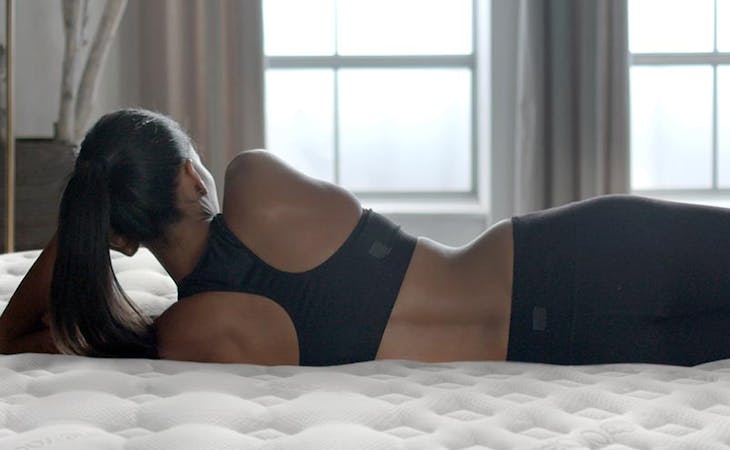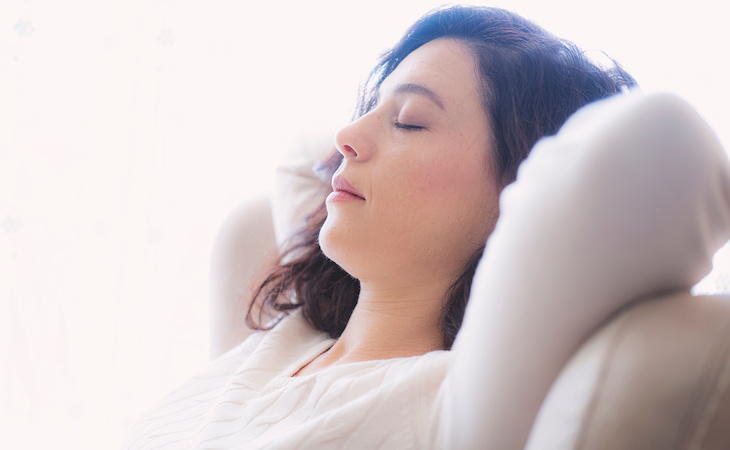If you’ve ever struggled with back pain, you know that making it through the day is only half the battle—then, there’s trying to fall asleep (and stay asleep) come bedtime. While your mattress might not be the source of your back pain, it could be contributing to it.
Sleeping on the wrong mattress won’t allow for the proper support or comfort your body needs, especially if you’re trying to heal from an injury or dealing with chronic back pain, says Wisconsin-based chiropractor Tom Tozer.
Choosing the right mattress for back pain
Conversely, the right mattress can give your muscles and joints just enough cushioning to rest and recover. In fact, making the switch to a new mattress can slash back pain in half and improve sleep quality by just as much, finds a small study published in the Journal of Chiropractic Medicine.
If you’ve had your mattress for seven years or so, it might be time for a new one, especially if you’re waking up with more stiffness and pain than before you tucked in, notes the Better Sleep Council.
One of the best mattress materials for back pain is memory foam, which conforms to your body to keep your spine in neutral alignment and hugs your pressure points to relieve soreness.
This guide will help you find the best memory foam mattress for back pain.
Memory foam mattresses and back pain: what you need to know
Read on to learn how memory foam mattresses can help cushion your body and, in turn, soothe your sore back.
How back pain affects sleep
The National Sleep Foundation recommends seven to nine hours of sleep each night for your body and mind to be ready to take on the day, says Bill Fish, certified sleep science coach and co-founder of the sleep website Tuck. Unfortunately, back pain can make it difficult to find a comfortable position and result in a night full of wake-ups.
Even worse, research suggests poor sleep can worsen back pain—the less sleep you get, the more susceptible you may be to chronic pain. A bad night’s sleep means you’re more likely to wake up in pain and suffer from a low mood too, per a recent study in Annals of Behavioral Medicine.
Whether your back pain is caused by a condition like arthritis, an injury, or mechanical issues (meaning your back is misaligned in some way), comfort and support are essential for overnight pain relief and recovery, says Tozer. The key is to allow your back to rest in proper alignment, the same position as when you’re standing perfectly upright.
How a memory foam mattress works to prevent back pain
Memory foam mattresses are not a single block of memory foam; if they were, they’d be too soft to sleep on. Instead, premium memory foam mattresses feature layers of foams in varying thicknesses and densities.
Typically, a memory foam mattress will have a polyfoam support core, topped by layers of transition foam. Above that is a comfort layer (or multiple layers) of body-hugging memory foam. The memory foam softens in response to heat and pressure, allowing it to perfectly contour and support your muscles and joints.
Keep in mind: The higher the foam density, the higher quality and more durable the mattress. A good memory foam mattress has a lifespan of 10 to 15 years. For most sleepers, foam density of four to five pounds per cubic foot is in the “sweet spot” for both comfort and quality. Less than that, and the memory foam mattress will be too soft and quicker to break down; much more, and you’ll be paying a lot for something you may not need.
How to find the best memory foam mattress for back pain
Here are four ways a memory foam mattress can offer relief from back pain:
1. Memory foam mattresses keep your spine in proper alignment
A lack of support in your mattress can contribute to the progression of an unhealthy spine and the pain that comes with it, says Tozer. As memory foam mattresses conform to your body, they help keep your spine in a neutral position, no matter your sleeping position. However, if you or your partner are on the heavier side (think: 200 pounds or more), you might want to consider a more supportive option, like a latex or hybrid mattress.
If you’re a side sleeper, consider a softer memory foam mattress to reduce the pressure on your shoulders and hips. If you’re a back sleeper or stomach sleeper, on the other hand, you’re better off with a medium-firm mattress to avoid sinking too deeply into the bed (though Tozer advises against sleeping on your stomach if you can help it, as it places excess stress on your neck).
2. Memory foam mattresses provide must-have lumbar support
If you can feel your waist or hips sinking into your mattress, that’s a sign you’re not getting enough lumbar support (a.k.a. lower back support), which can worsen back health and aches and pains, says Tozer. The fix: Look for a memory foam mattress with denser foam in the center third, which can give your muscles the extra support they need to relax.
3. Memory foam mattresses hug your muscles and joints
Sinking into memory foam provides welcome relief for muscles that have been firing away to try to find the right sleeping position through back pain. “The conforming characteristics of memory foam soothe the sleeper and relieve pressure in the spots that are in contact with the mattress,” explains Fish. Body-hugging memory foam cradles the pressure points of your hips and shoulders, allowing your muscles and joints to release tension and rest at last.
4. Memory foam mattresses allow for adjustments throughout the night
These days, virtually all memory foam mattresses are compatible with an adjustable base. That’s good news if you’re dealing with back pain, says Tozer, as slightly elevating your head or feet can take off some of the normal tension from your spine and, in turn, help relieve your pain. Beyond this, if you’re dealing with a back injury, taking the weight off gives your muscles the ability to rest and recover.
If you’re in the market for a new memory foam mattress, make sure yours is the proper fit by choosing a company that allows for a sleep trial period, advises Tozer. That way, you’ll be able to sleep on it for a few weeks and ensure your back’s finally getting the support it needs.






